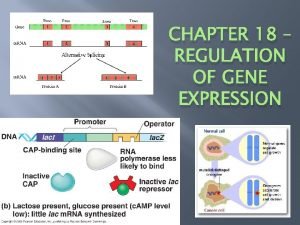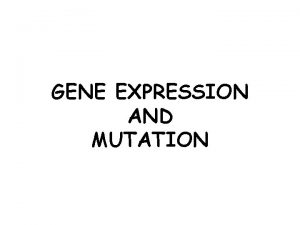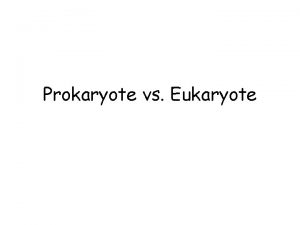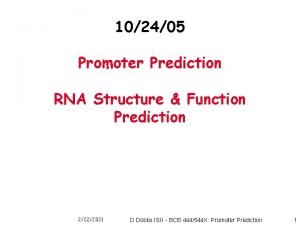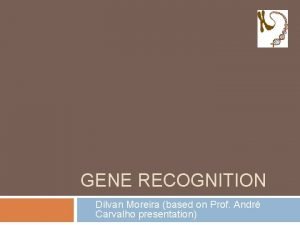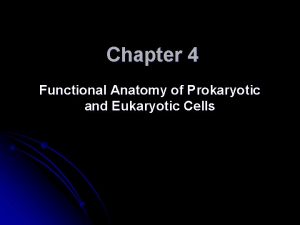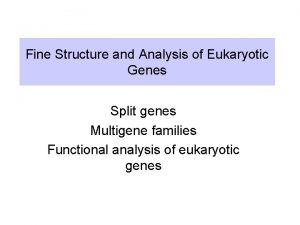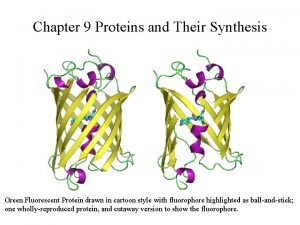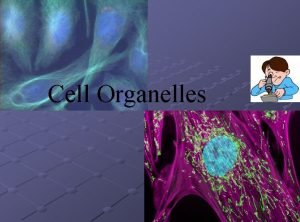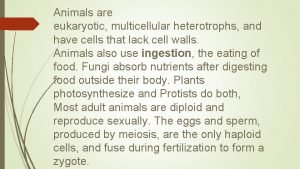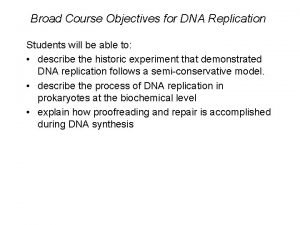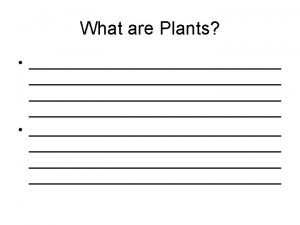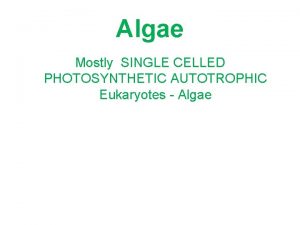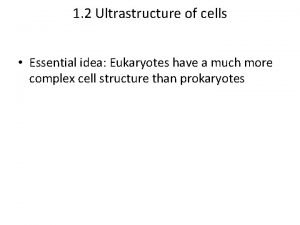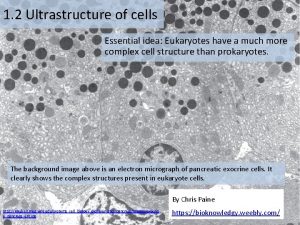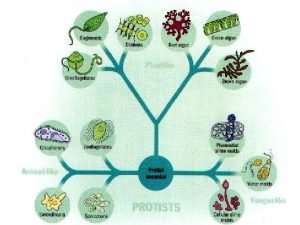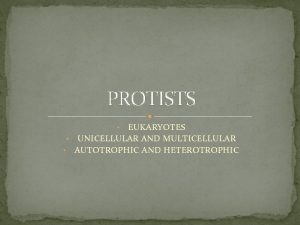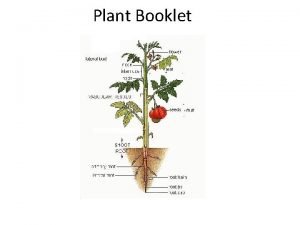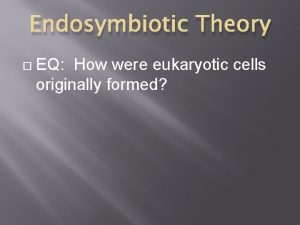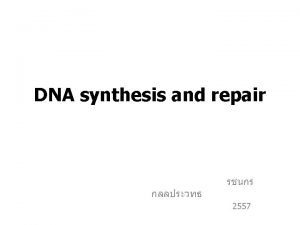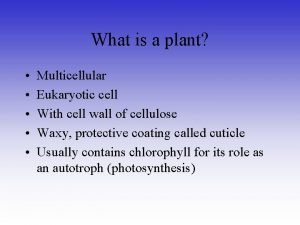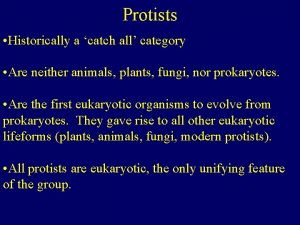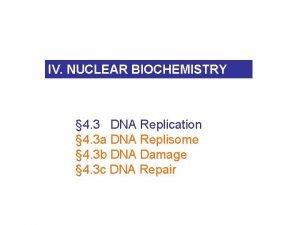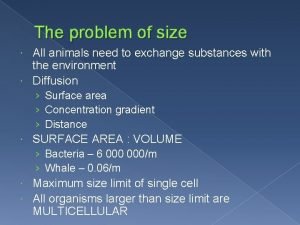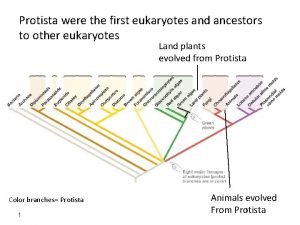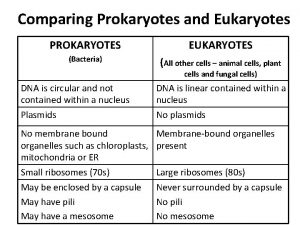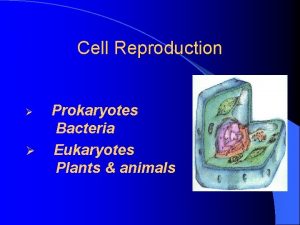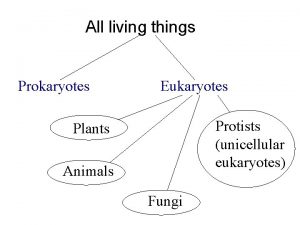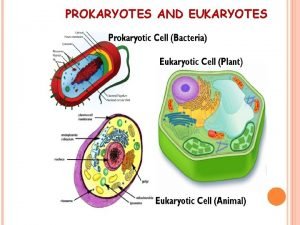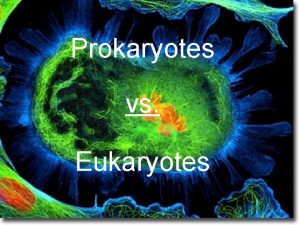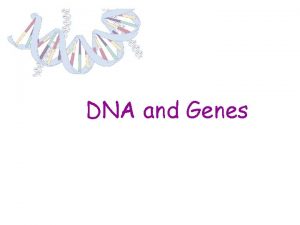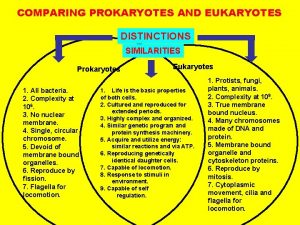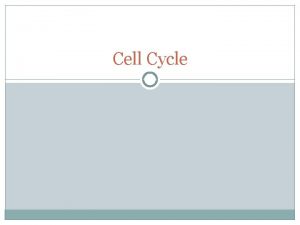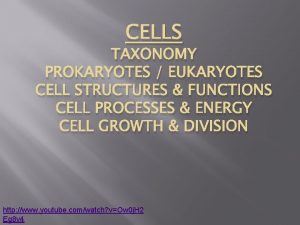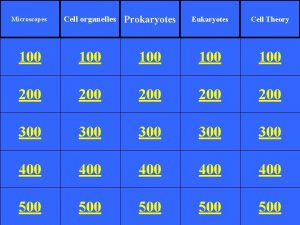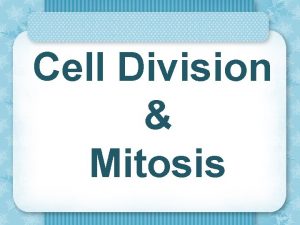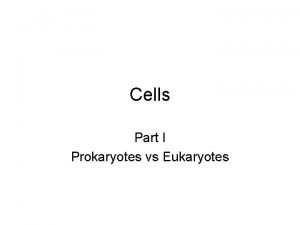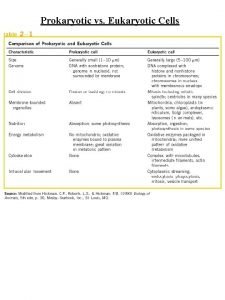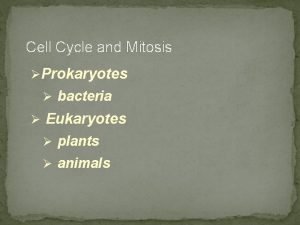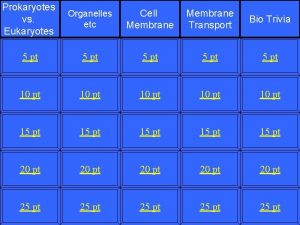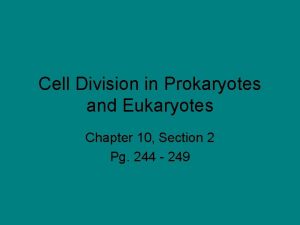THE CELL PROKARYOTES EUKARYOTES TYPES OF CELL Prokaryotes











































- Slides: 43

THE CELL (PROKARYOTES – EUKARYOTES)

TYPES OF CELL : Prokaryotes Eukaryotes

PROKARYOTES: They are Micro-organisms where the DNA is concentrated as Neocloid body and the DNA is a single strand or a double strand.

Prokaryotes Bacteria Archaea (exists in most environments) (exists in hot and salty environments)

TYPES OF PROKARYOTIC : Prokaryotic Bacteria Archaea

PROKARYOTIC & EUKARYOTIC Similarities All cells are surrounded by a plasma membrane. The semi-fluid substance within the cell is called “cytosol”, containing the cell organelles. All cells contain chromosomes which have genes in the form of DNA. All cells have tiny organelles called “Ribosomes” that make proteins. Differences A major difference between prokaryotic and eukaryotic cells is the location of chromosomes. In an eukaryotic cell, chromosomes are contained in a true nucleus. In a prokaryotic cell, the DNA is concentrated in the nucleoid without a membrane separating it from the rest of the cell. In prokaryotic cell, DNA is a single strand or double strand DNA. But in eukaryotic cell, DNA is double strand.

1 -BACTERIA Its consisted of : 1. The Bacterial capsule: its a protective layer 2. that surrounds the bacteria and helps it stick to the host cell and increases its own resistance to the hosts defenses. The Bacterial cell wall: it maintains the shape’s cell and prevents it from bursting in a hypotonic environment as well as protection.

BACTERIA Functions: vmaintains the shape: of the Functions cell. v. Adhere bacteria cells to their v affords physical protection substratum. v the cell from vprevents Increase bacteria resistance bursting in a hypotonic to host defenses. environment. v. Stick bacterial cells together when live as colonies. NOTE: v. Protect bacterial cell. The walls of Archaea lack peptidoglycan

1 -BACTERIA Its consisted of : 1. The Bacterial capsule: its a protective layer 2. that surrounds the bacteria and helps it stick to the host cell and increases its own resistance to the hosts defenses. The Bacterial cell wall: it maintains the shape’s cell and prevents it from bursting in a hypotonic environment as well as protection.

THE GRAM’S STAIN It is a tool for identifying specific bacteria, based on differences in their cell walls. ( Types based on Gram’s Stain ) Their cell walls have large amounts of peptidoglycans that react with Gram’s stain (appear violet-stained). their cell walls have no or small amount of peptidoglycan. So, do not react or very weakly react with Gram’s stain (do not appear stained)

THE GRAM’S STAIN Ø Gram-negative species are pathogenic more threatening) than gram-positive species. Ø Gram-negative bacteria are commonly more resistant than gram-positive species to antibiotics.

Prokaryotes reproduce only asexually by binary fission A single cell produce a colony of offspring PRODUCTION OF BACTERIA §

Nutrition refers to how an organism obtains energy and a carbon source from the environment to build the organic molecules of its cells. Autotrophs Heterotrophs CO 2 as Carbon source Organic compounds as Carbon Source Photo. Autotrophs Chemo. Autotrophs Photo. Heterotrophs Light as energy source Chemicals as energy source Light as energy source CO 2 as C source Organic compounds as C source Chemo. Heterotrophs organic substances as a source for both energy and carbon

VIRUSES

VIRUSES ARE MUCH SMALLER THAN BACTERIA

VIRUS IS ABOUT 20 NM IN DIAMETER ACTUALLY VIRUSES ARE NOT CELLS

A VIRUS IS A GENOME ENCLOSED IN A PROTECTIVE COAT

VIRAL CAPSID A protein shell that encloses the viral genome. It is rode-shaped, helical, polyhedral or more complex.

Capsomeres: Are the protein units that form capsid.

ENVELOPE Some viruses have viral envelopes, envelopes membranes cloaking their capsids. These envelopes are derived from the membrane of the host cell.

VIRAL GENOME: (HEREDITARY MATERIAL) Viral genomes may consist of: double-stranded single-stranded DNA (ss. DNA), double-stranded single-stranded DNA (ds. DNA), RNA (ds. RNA), RNA (ss. RNA). depending on the specific type of virus. The viral genome is usually organized as a single linear or circular molecule of nucleic acid. The smallest viruses have only four genes, genes while the largest have several hundred

VIRAL GENOME (HEREDITARY MATERIAL ) ds. DNA ss. DNA ds. RNA ss. RNA double-stranded DNA Single-stranded DNA Double-stranded RNS Single-stranded RNA The viral genome is usually organized as a single linear or circular molecule of nucleic acid. The smallest viruses have only four genes, while the largest have several hundred.

VIRUSES WITH AN OUTER ENVELOPE USE THE ENVELOPE TO ENTER THE HOST CELL. NOTE: These enveloped viruses do not necessarily kill the host cell. Glycoproteins on the envelope bind to specific receptors on the host’s membrane. The envelope fuses with the host’s membrane, transporting the capsid and viral genome inside. The viral genome duplicates and directs the host’s protein synthesis machinery to synthesize capsomeres with free ribosomes and glycoproteins with bound ribosomes. After the capsid and viral genome selfassemble, they bud from the host cell covered with an envelope derived from the host’s plasma membrane, including viral glycoproteins.

It is retrovirus and it includes: v an envelope with glycolproteins, v a capsid containing THE VIRUS two identical RNA strands as its genome v two copies of reverse transcriptase. HIV VIRUS THAT CAUSES AIDS

It has a 20 -sided capsid-head that encloses their DNA and protein tail piece that attaches the phage to the. OR host and injects the phage DNA inside. BACTERIA INFECTING VIRUSES BACTERIOPHAGES

TYPES BY CYCLE Lytic The phage reproductive cycle results in the death of the host. In the last stage, the bacterium lyses (breaks open) and releases the phages produced within the cell to infect others. Virulent phages reproduce only by a lytic cycle. Lysogenic The phage genome replicates without destroying the host cell. Temperate phages, like phage lambda. May use both lytic and lysogenic cycles. During a lytic cycle, the viral gene immediately turn the host cell into a virus-producing factory, and the cell soon lyses and releases its viral products.

PHAGE T 4 • Reproduced by a lytic cycle only • It’s a “Virulent virus” that causes the death of the host


PHAGE LAMBDA • It may use both Lytic and Lysogenic cycles • It’s a “Temperate virus”

phage lambda Phage T 4

EXAMPLES Lytic Lysogenic Lytic Phage T 4 Phage Lambda Many tail fiber Only 1 tail fiber

Bacteriophages Phage lambda Lysogenic cycle Lytic cycle Phage T 4 Lytic cycle

KEY CHARACTERS VIRUSES

DNA enclosed in a protein coat (sometimes, membranous envelop also)

Can be crystallised

Each type of virus infects a limited range of host cells ( host range )

They lack enzymes for metabolism

Have no ribosomes for making their own proteins

Reproduced only within a living host cell ( obligate parasitism ).

Most viruses of eukaryotes attack specific tissues. eg. Human cold viruses infect only the cells lining the upper respiratory tract, and AIDS virus binds only to certain white blood cells (Immune system).

Some questions for More understanding

Q 1: Write whether each of the following statements is True (T) or False (F): 1 - Gram staining of bacteria depends on the amount of peptidoglycan which exists in the cell wall. 2 - Lysogenic cycle of viruses results in death of the host cell. 3 - Bacteria and viruses are classified as eukaryotes. 4 - All prokaryotes are autotrophs. 5 -The genome in influenza virus and human immunodeficiency virus( HIV)is DNA while in. T 4 bacteriophage is RNA. 6 - Chemoheterotrophs , use organic molecules for both energy and carbon source.

Q 2: Choose the correct answer (one answer only): 1 - Viral capsid is made up of: a- protein. c- lipid. b- carbohydrates. d- both a and b. 2 -Which of the following would be found in animal cells but not in bacteria cells? a-DNA. b-plasma membrane. c-endoplasmic reticulum. d-ribosomes. 3 -Organisms that use light as energy source&organic substances as carbon source are : - a-photoheterotrophs. c-photoautotrophs. 4 - The nucleic acids of viruses may be: a- RNA. b- DNA. c- a and b. d- a or b. 5 - Gram staining of bacteria depends on the amount of peptidoglycan which exists in: b-chemoautotrophs. d-chemoheterotrophs. a)- capsule b)- cell wall c)- plasma membrane d)- nucleoid 6 -Which of the following characteristics or processes is common to both bacteria and viruses? a- binary fission. b- ribosomes in cytoplasm. c-nucleic acid as the genetic material. 7 - Phage-λ reproduce in the bacterial cell by: a)- lytic cycle c)- mitotic division b)- lysogenic cycle d)- binary fission 8 - Bacterial capsule is important for: a)- adherence of bacteria to each other c)- protection b)- adherence of bacteria to substratum d)- all of the above
 Prokaryotes vs eukaryotes gene regulation
Prokaryotes vs eukaryotes gene regulation Prokaryotes vs eukaryotes venn diagram
Prokaryotes vs eukaryotes venn diagram Prokaryotes vs eukaryotes gene regulation
Prokaryotes vs eukaryotes gene regulation Small vacuoles
Small vacuoles Diff between prokaryotes and eukaryotes
Diff between prokaryotes and eukaryotes Cytoskeleton nickname
Cytoskeleton nickname Differences between prokaryotic and eukaryotic cells
Differences between prokaryotic and eukaryotic cells Prokaryotic cells vs. eukaryotic cells
Prokaryotic cells vs. eukaryotic cells Prokaryotes vs eukaryotes
Prokaryotes vs eukaryotes Multiple choice questions on prokaryotes and eukaryotes
Multiple choice questions on prokaryotes and eukaryotes Gene prediction in prokaryotes and eukaryotes
Gene prediction in prokaryotes and eukaryotes Prokaryotes vs eukaryotes chart
Prokaryotes vs eukaryotes chart Polimerase
Polimerase Prokaryotes vs eukaryotes venn diagram
Prokaryotes vs eukaryotes venn diagram Which organisms are prokaryotes
Which organisms are prokaryotes Functional anatomy of prokaryotic and eukaryotic cells
Functional anatomy of prokaryotic and eukaryotic cells How many dna polymerase in eukaryotes
How many dna polymerase in eukaryotes Types of dna polymerase in eukaryotes
Types of dna polymerase in eukaryotes Multicellular organisms images
Multicellular organisms images Dna transcription
Dna transcription Characteristics of eukarya domain
Characteristics of eukarya domain Fine structure analysis of eukaryotes
Fine structure analysis of eukaryotes Translation in bacteria vs eukaryotes
Translation in bacteria vs eukaryotes Cytoskeleton prokaryotic or eukaryotic
Cytoskeleton prokaryotic or eukaryotic All animals are multicellular heterotrophic eukaryotes
All animals are multicellular heterotrophic eukaryotes Prokaryotic cell and eukaryotic cell similarities
Prokaryotic cell and eukaryotic cell similarities Linear chromosomes in eukaryotes
Linear chromosomes in eukaryotes Plants are multicellular eukaryotes
Plants are multicellular eukaryotes Fucus autotrophic or heterotrophic
Fucus autotrophic or heterotrophic Eukaryotes main idea
Eukaryotes main idea Eukaryotes main idea
Eukaryotes main idea Heterotrophic eukaryotes definition
Heterotrophic eukaryotes definition Eukaryotic, unicellular, and autotrophic
Eukaryotic, unicellular, and autotrophic Plants are multicellular eukaryotes
Plants are multicellular eukaryotes Aerobic eukaryotes
Aerobic eukaryotes Dna polymerase proofreading
Dna polymerase proofreading Plants are multicellular eukaryotes
Plants are multicellular eukaryotes Sarcodinia
Sarcodinia Chi square test for linkage
Chi square test for linkage Intercalating agents
Intercalating agents Heterogamy in eukaryotes
Heterogamy in eukaryotes Protist evolution
Protist evolution Are cell walls prokaryotic or eukaryotic
Are cell walls prokaryotic or eukaryotic Hát kết hợp bộ gõ cơ thể
Hát kết hợp bộ gõ cơ thể


